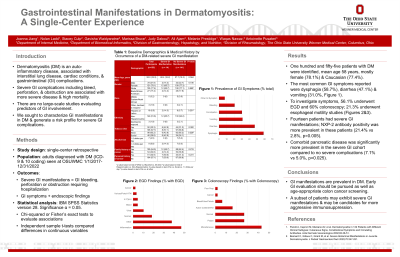Monday Poster Session
Category: General Endoscopy
P2388 - Prevalence of Severe Gastrointestinal Manifestations in Dermatomyositis
Monday, October 28, 2024
10:30 AM - 4:00 PM ET
Location: Exhibit Hall E

Has Audio

Joanna Jiang, MD
The Ohio State University Wexner Medical Center
Columbus, OH
Presenting Author(s)
Joanna Jiang, MD, Nolan Ladd, MD, Antoinette Pusateri, MD, Gavisha Waidyaratne, MD, Marissa Bruce, MD, Melanie Prestidge, MD, Judy Daboul, MD, Ali Ajam, MD, Waqas Nawaz, MD
The Ohio State University Wexner Medical Center, Columbus, OH
Introduction: Dermatomyositis (DM) is a rare autoimmune disorder that typically involves the skin and proximal muscles and often presents with GI symptoms such as dysphagia. Severe GI manifestations like perforation are relatively rare but associated with high mortality. There are currently no large, retrospective studies to determine predisposing factors to such manifestations. We aim to characterize gastrointestinal involvement in DM patients.
Methods: This is a single-center retrospective cohort study of adults diagnosed with DM who were seen at The Ohio State University Wexner Medical Center from 1/1/2017 to 12/31/2022. Comprehensive chart review included demographics, medical history, and GI procedural history. Small and large bowel involvement of DM was captured by looking for GI symptoms and endoscopic and imaging findings. Hospitalization history for DM was recorded, detailing any GI involvement or complications.
Results:
We identified 155 patients with DM within the study period. Mean age at diagnosis was 58.0 years. Most were female (78.1%) and White (77.4%). At least one positive autoantibody was identified in 125 patients, with the most common being ANA (64.9%), SS-A (24.5%), and anti-Jo-1 (9.7%). Cutaneous involvement was seen in 90.3% and neuromuscular involvement in 78.0%. Pharmacotherapy varied: 61.9% were on IVIG, 94.8% on steroids, 52.9% on hydroxychloroquine and 56.1% on mycophenolate.
The incidence of GI symptoms was high: 58.7% were evaluated for dysphagia, 31.0% for vomiting, 47.1% for diarrhea, and 30.3% for constipation. Of those with documented upper endoscopies, 36.8% had significant inflammation, 16.1% had ulcers, 2.3% had angiodysplasia, 4.6% had other bleeds, 9.2% had stenosis, 4.6% had H. pylori, and 3.4% had identified malignancy. Colonoscopy results are summarized in Table 1. Severe manifestations included GI bleeding (20.6%), perforation (3.9%), and pneumatosis (3.9%). Hospitalizations related to DM occurred in 37.4% of patients; 9.0% were admitted for severe GI complications.
Discussion: To our knowledge, this is the largest retrospective review to date characterizing GI pathology in adults with DM. These results highlight the importance of screening all patients with DM for GI symptoms, not only as part of malignancy workup but also to evaluate for severe complications. Future steps will involve multivariate analyses identify specific predictors of such GI manifestations.
Note: The table for this abstract can be viewed in the ePoster Gallery section of the ACG 2024 ePoster Site or in The American Journal of Gastroenterology's abstract supplement issue, both of which will be available starting October 27, 2024.
Disclosures:
Joanna Jiang, MD, Nolan Ladd, MD, Antoinette Pusateri, MD, Gavisha Waidyaratne, MD, Marissa Bruce, MD, Melanie Prestidge, MD, Judy Daboul, MD, Ali Ajam, MD, Waqas Nawaz, MD. P2388 - Prevalence of Severe Gastrointestinal Manifestations in Dermatomyositis, ACG 2024 Annual Scientific Meeting Abstracts. Philadelphia, PA: American College of Gastroenterology.
The Ohio State University Wexner Medical Center, Columbus, OH
Introduction: Dermatomyositis (DM) is a rare autoimmune disorder that typically involves the skin and proximal muscles and often presents with GI symptoms such as dysphagia. Severe GI manifestations like perforation are relatively rare but associated with high mortality. There are currently no large, retrospective studies to determine predisposing factors to such manifestations. We aim to characterize gastrointestinal involvement in DM patients.
Methods: This is a single-center retrospective cohort study of adults diagnosed with DM who were seen at The Ohio State University Wexner Medical Center from 1/1/2017 to 12/31/2022. Comprehensive chart review included demographics, medical history, and GI procedural history. Small and large bowel involvement of DM was captured by looking for GI symptoms and endoscopic and imaging findings. Hospitalization history for DM was recorded, detailing any GI involvement or complications.
Results:
We identified 155 patients with DM within the study period. Mean age at diagnosis was 58.0 years. Most were female (78.1%) and White (77.4%). At least one positive autoantibody was identified in 125 patients, with the most common being ANA (64.9%), SS-A (24.5%), and anti-Jo-1 (9.7%). Cutaneous involvement was seen in 90.3% and neuromuscular involvement in 78.0%. Pharmacotherapy varied: 61.9% were on IVIG, 94.8% on steroids, 52.9% on hydroxychloroquine and 56.1% on mycophenolate.
The incidence of GI symptoms was high: 58.7% were evaluated for dysphagia, 31.0% for vomiting, 47.1% for diarrhea, and 30.3% for constipation. Of those with documented upper endoscopies, 36.8% had significant inflammation, 16.1% had ulcers, 2.3% had angiodysplasia, 4.6% had other bleeds, 9.2% had stenosis, 4.6% had H. pylori, and 3.4% had identified malignancy. Colonoscopy results are summarized in Table 1. Severe manifestations included GI bleeding (20.6%), perforation (3.9%), and pneumatosis (3.9%). Hospitalizations related to DM occurred in 37.4% of patients; 9.0% were admitted for severe GI complications.
Discussion: To our knowledge, this is the largest retrospective review to date characterizing GI pathology in adults with DM. These results highlight the importance of screening all patients with DM for GI symptoms, not only as part of malignancy workup but also to evaluate for severe complications. Future steps will involve multivariate analyses identify specific predictors of such GI manifestations.
Note: The table for this abstract can be viewed in the ePoster Gallery section of the ACG 2024 ePoster Site or in The American Journal of Gastroenterology's abstract supplement issue, both of which will be available starting October 27, 2024.
Disclosures:
Joanna Jiang indicated no relevant financial relationships.
Nolan Ladd indicated no relevant financial relationships.
Antoinette Pusateri indicated no relevant financial relationships.
Gavisha Waidyaratne indicated no relevant financial relationships.
Marissa Bruce indicated no relevant financial relationships.
Melanie Prestidge indicated no relevant financial relationships.
Judy Daboul indicated no relevant financial relationships.
Ali Ajam indicated no relevant financial relationships.
Waqas Nawaz indicated no relevant financial relationships.
Joanna Jiang, MD, Nolan Ladd, MD, Antoinette Pusateri, MD, Gavisha Waidyaratne, MD, Marissa Bruce, MD, Melanie Prestidge, MD, Judy Daboul, MD, Ali Ajam, MD, Waqas Nawaz, MD. P2388 - Prevalence of Severe Gastrointestinal Manifestations in Dermatomyositis, ACG 2024 Annual Scientific Meeting Abstracts. Philadelphia, PA: American College of Gastroenterology.

